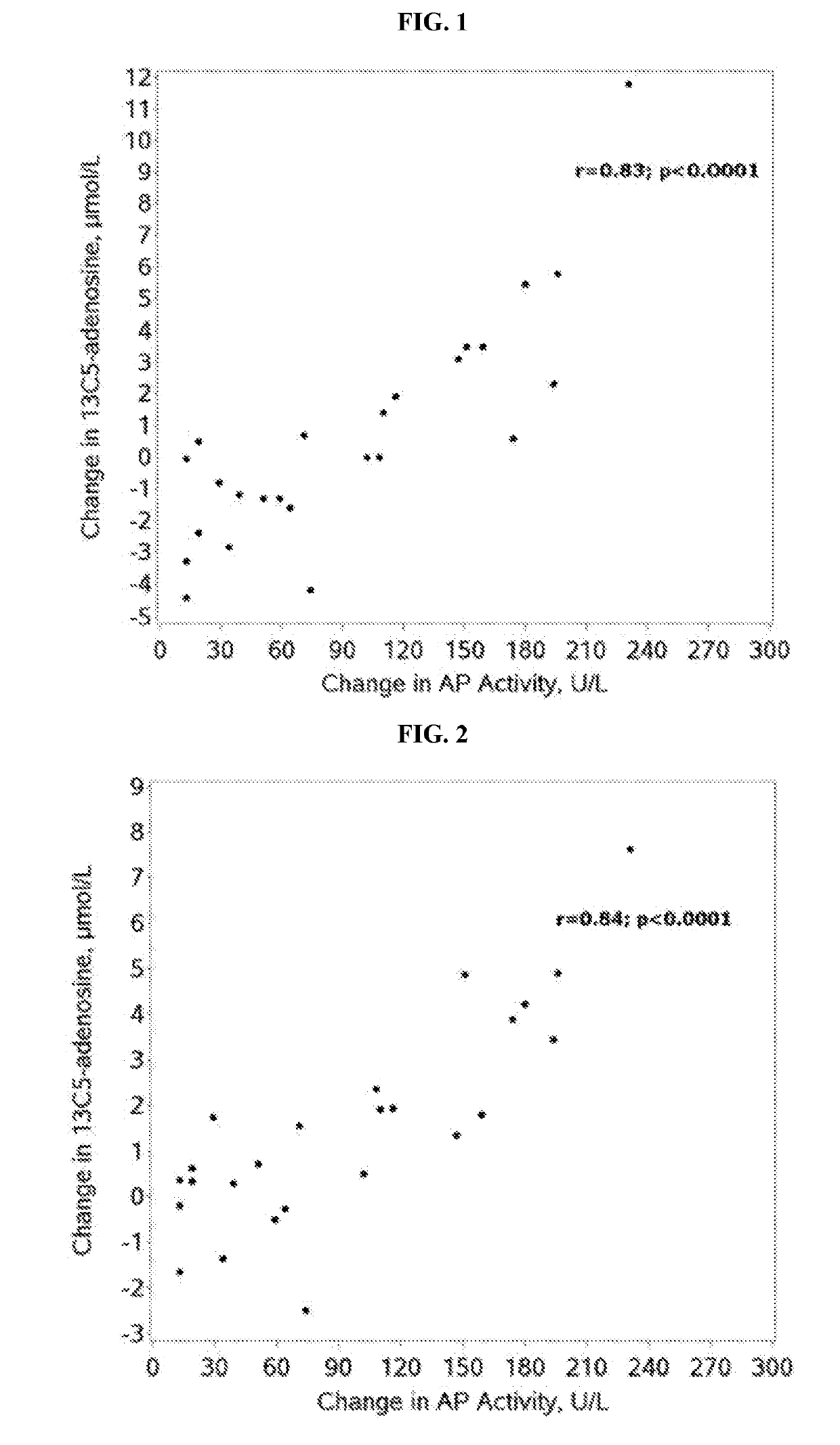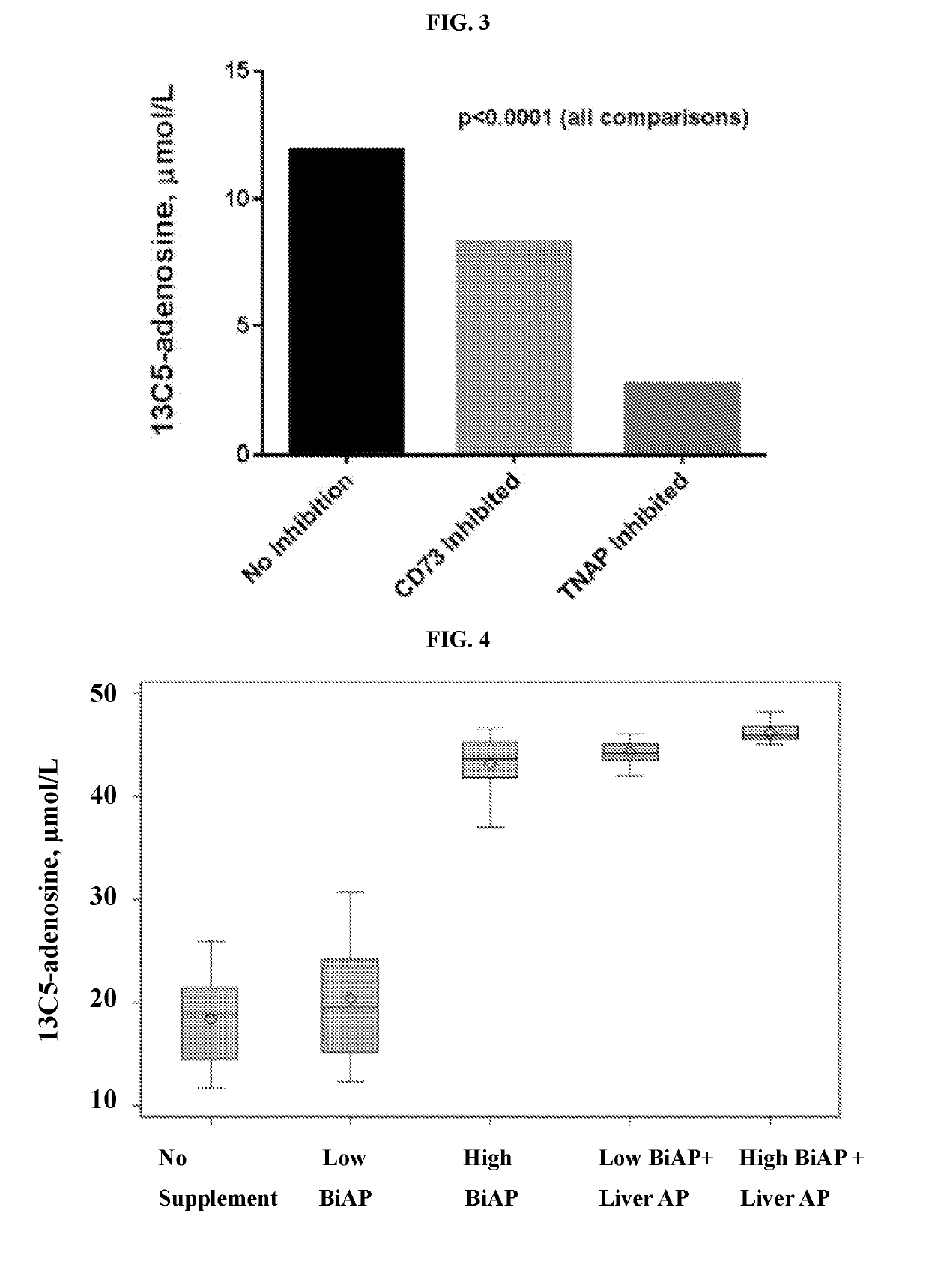Compounds, compositions and methods for preventing and/or treating inflammation and/or organ dysfunction after pediatric cardiovascular surgery
a technology for organ dysfunction and compositions, applied in the field of compound compositions and methods for preventing and/or treating inflammation and/or organ dysfunction after pediatric cardiovascular surgery, can solve the problems of incomplete understanding of organ injury/dysfunction, global ischemia/reperfusion, and the risk of death or transplantation in the first year of life remains >25% for complex surgeries, so as to reduce the levels of extracellular adenine nucleotide, inhibit and/or reduce blood coagulation
- Summary
- Abstract
- Description
- Claims
- Application Information
AI Technical Summary
Benefits of technology
Problems solved by technology
Method used
Image
Examples
example 1
Phosphatase, Soluble Extracellular Adenine Nucleotides, and Adenosine Production after Infant Cardiopulmonary Bypass
[0114]The potential therapeutic mechanisms of AP in cardiac surgery settings are unclear. All APs are capable of hydrolytic phosphatase activity targeting a variety of molecules. Perhaps the most intriguing targets are extracellular adenine nucleotides released through cellular apoptosis or necrosis during ischemia / reperfusion injury. Extracellular adenosine triphosphate (ATP), adenosine diphosphate (ADP), and adenosine monophosphate (AMP) lead to inflammatory activation, vasoconstriction, and platelet activation, while stepwise dephosphorylation of these substrates to adenosine may be protective. In healthy neonates, AP serves as the primary serum enzyme responsible for the conversion of extracellular AMP to adenosine.
[0115]Given this function of AP in the healthy neonate, it is possible that the decrease in AP activity routinely seen after infant cardiothoracic surge...
example 2
Phosphatase in Infant Cardiopulmonary Bypass: Kinetics and Relationship to Organ Injury and Major Cardiovascular Events
[0151]In certain embodiments, AP can play an important role after cardiothoracic surgery. AP activity decreases after cardiothoracic surgery in adults and children. In addition, low post-operative serum AP activity is independently associated with increased post-operative support requirements in infants. However, significant gaps exist in the understanding of AP after infant cardiothoracic surgery, including the timing and persistence of decreased AP activity, isoform-specific changes, the balance of enzyme loss versus deactivation, and the association with major cardiovascular events as well as organ injury.
[0152]The present study was designed to address these knowledge gaps. In certain non-limiting embodiments, loss of AP activity can begin during surgery and continue through the initial post-operative period. Activity of all AP isoforms could be equally affected ...
example 3
Clot Initiation, Amplification and Propagation in Healthy Human Adult Donors
[0183]AP dephosphorylates various types of molecules, including endotoxin, nucleotide phosphates, and pro-coagulant polyphosphates (polyp). AP activity falls after CV surgery and low levels are associated with increased post-operative support and organ injury / dysfunction. Persistent low AP levels at 72 hrs post-op is independently associated with increased odds of cardiac arrest, mechanical circulatory support, or death. AP's mechanism of protection and its effects on coagulation are currently unknown. Viscoelastic instrumentation such as the Sonoclot (SCP2) can show changes in hemostasis by utilizing real time sample clot formation monitoring.
[0184]The present study has in part the objective of determining the effect of AP on hemostasis in healthy human adult donors using the SCP2 to provide coagulation factor specific results, focusing on activated clotting time (ACT) (clot initiation) and clot rate (CR) (...
PUM
| Property | Measurement | Unit |
|---|---|---|
| Time | aaaaa | aaaaa |
| Fraction | aaaaa | aaaaa |
| Fraction | aaaaa | aaaaa |
Abstract
Description
Claims
Application Information
 Login to View More
Login to View More - R&D
- Intellectual Property
- Life Sciences
- Materials
- Tech Scout
- Unparalleled Data Quality
- Higher Quality Content
- 60% Fewer Hallucinations
Browse by: Latest US Patents, China's latest patents, Technical Efficacy Thesaurus, Application Domain, Technology Topic, Popular Technical Reports.
© 2025 PatSnap. All rights reserved.Legal|Privacy policy|Modern Slavery Act Transparency Statement|Sitemap|About US| Contact US: help@patsnap.com



